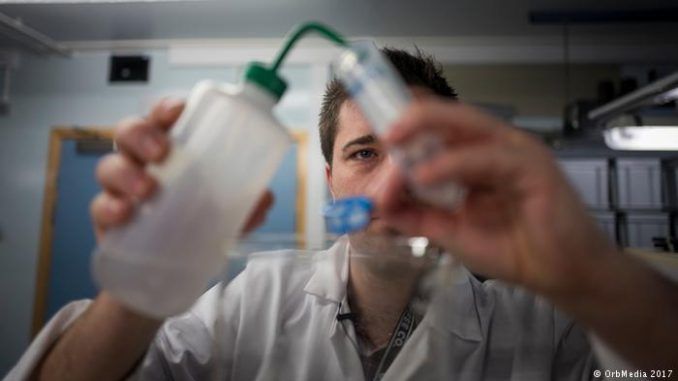
Microscopic plastic fibers found in drinking water around the world are making men infertile, according to a recent investigation conducted by Orb Media.
Researchers found plastic contamination in 83% of drinking water samples gathered from over a dozen countries on five continents.
Commondreams.org reports: For what’s been deemed the “first global tap water survey of plastic pollution,” Orb worked with researchers at the State University of New York and the University of Minnesota to test 159 samples.

BYPASS THE CENSORS
Sign up to get unfiltered news delivered straight to your inbox.
You can unsubscribe any time. By subscribing you agree to our Terms of Use
The U.S. had the highest levels of contamination, with 94 percent of its 33 samples testing positive for plastic fibers. Sources of contaminated tap water in the U.S. included Congressional buildings, Trump Tower in New York City, and even the U.S. Environmental Protection Agency headquarters.
“This should knock us into our senses,” Muhammad Yunus, the 2006 Nobel Peace Prize laureate, said in a statement to PRI. “We knew that this plastic is coming back to us through our food chain. Now we see it is coming back to us through our drinking water.”
Precisely what that means for humans, though, will require additional studies. As Lincoln Fok, an environmental scientist at the Education University of Hong Kong, told PRI: “The research on human health is in its infancy.”
A PBS report on microplastic contamination, published in May, summarized what limited scientific research on the subject has revealed so far:
Some laboratory studies have found that microplastics can interfere with feeding, digestion, and reproduction in several aquatic species. While microplastics may physically harm organisms, there’s also concern that they could leach chemicals such as plasticizers, UV stabilizers, flame retardants, and colorants. In addition to what’s in them, microplastics have also been found to attract pesticides and other toxic chemicals in water.
Although the new Orb study “raises more questions than it answers,” as former New York City water commissioner Albert Appleton told PRI, among scientists’ highest concerns is the fact that studies have shown tiny plastic fibers absorb nearby toxins—meaning dangerous chemicals that may otherwise be filtered out before reaching household taps could be trapped in the microplastics and consumed.
According to Sherri Mason, a microplastic expert at the State University of New York in Fredonia who supervised the analyses for Orb, while more research is needed to understand the full human impact, studies of plastic contamination’s impact on animals have revealed enough to raise alarms about what high levels of plastic fibers in drinking water worldwide will mean for humans.
“We have enough data from looking at wildlife, and the impacts that it’s having on wildlife, to be concerned,” she said. “If it’s impacting them, then how do we think that it’s not going to somehow impact us?”
In 2014, Mason and some of her students studied the guts of fish caught in Lake Erie. “Her team found plastic in the majority of the fish they tested,” PBS reported, and “the biggest source they found were minuscule plastic fibers.”
“You could actually see the fibers enmeshed in the gastrointestinal tract,” Mason told PBS.Mason’s research team “found tens to hundreds of thousands of pieces of plastic per square mile of surface water in the Great Lakes”—the largest freshwater system in the world.
The sources of microplastic contamination are wide-ranging, Orb Media reports, but major contributors include:
- Synthetic fibers in clothing made of fleece, acrylic, and polyester, which “emit thousands of microscopic fibers with every wash”;
- Tire dust, which washes into sewers that empty into waterways;
- Paints used on road signs, ships, and homes, which contribute “more than 10 percent of microplastic pollution in the oceans”;
- Mishandled plastic waste—e.g., forks, bags, straws—of which at least 8 million tons enter the world’s water resources each year;
- Synthetic fibers in the air—the sources of which scientists are only beginning to examine;
- Microbeads in personal care products—especially facial cleaners—which have been banned by the U.S. and Canada, but have already notably polluted waterways.


Don’t forget the Toxic Chemtrail plastic being sprayed in the air.
Maybe if it did a tad more than making men infertile…. let’s say taking away their S-drive , the world (which is still largely a men’s world) would finally take this seriously.Green parties have been knocking on industries door for ages to do something about this problem. But they were always told that it would be to costly so it would hurt us in the wallet .Mother Nature always a great force not to mess with, has taken refuge to some other tucked away item to protest/ take revenge, just a tad further and she’ll have a plastic-free world hitting them in the nuts instead of the wallet is a much better strategy